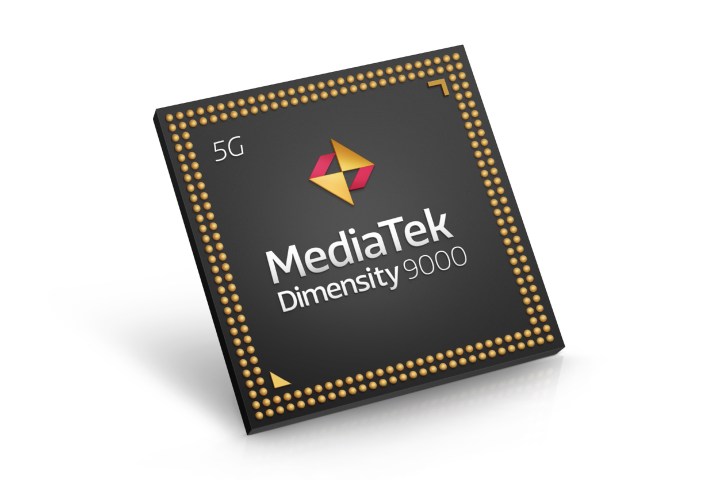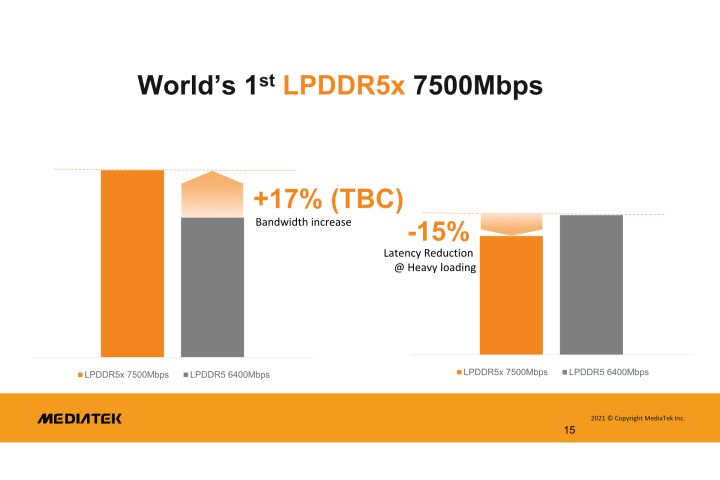The Dimensity 9000 is a new and supercharged flagship mobile chipset from MediaTek with many firsts in its segment. It is the first 4nm mobile chip, the first one to feature ARM’s new Cortex-X2 cores, and the first one to use the new Mali G710 GPU. In addition, the Dimensity 9000 is also the first mobile system on a chip (SoC) to support LPDDR5X RAM.
What is LPDDR5X RAM in the first place?
LPDDR5X is the newest standard in RAM technology for mobile devices and was only introduced early this year. The standard aims to improve the data transfer on the RAM chips used on mobile chipsets like the Dimensity 9000 and its counterparts in the Samsung Exynos and Qualcomm Snapdragon families.
While we have yet to see how the new standard actually improves the application of RAM on mobile devices, we do have some indications of the refinements LPDDR5X brings over LPDDR5. The following sections elaborate on how the two memory technologies compare.
LPDDR5X vs. LPDDR5 RAM

In July 2021, semiconductor trade organization JEDEC announced LPDDR5X as an evolution of the then-latest generation of Dynamic Random Access Memory (DRAM) — i.e. LPDDR5. This evolutionary standard, LPDDR5X, is designed to increase the data processing speed from 6400 Megabits per second (Mbps) to 8533Mbps, resulting in an increase of nearly 33%, corresponding to a 25% lower latency.
The older, LPDDR5 standard was first introduced in early 2020 with the Qualcomm Snapdragon 865. While the early devices running on the LPDDR5 standard could only run at speeds up to 5500Mbps, chipset vendors harnessed the full capabilities of the LPDDR5, pushing data transfer rates to 6400Mbps in subsequent updates. At the time of its launch, the focus was to improve the power efficiency by nearly 20% in LPDDR5 over its preceding standard, LPDDR4X.
While announcing the LPDDR5X standard, JEDEC made no claims about the improvements in efficiency, so we can expect DRAM manufacturers to make their own improvements.
Vendors gear up for LPDDR5X demand
While the technology is fairly at its nascent stage of adoption, two key DRAM vendors — Samsung Electronics and Micron Technology — have announced they will be making LPDDR5X RAMs for mobile chipsets. Here are the announcements from each of the semiconductor vendors:
Samsung Electronics
Earlier this month, Samsung Electronics announced it will be hopping on to the LPDRR5X train as it unveiled its 16 Gigabit (Gb) RAM developed on a 14nm DRAM manufacturing process.
Samsung announced that it will start collaborating with semiconductor manufacturers to “establish a more viable framework for the expanding world of digital reality.” The company envisions that the surge in the use of hyperconnected applications of technology — such as artificial intelligence (AI), augmented reality (AR), virtual reality (VR), and the metaverse — will lead to an increase in the demand for faster, large-scale data processing. This increase in demand for faster processing, as per Samsung, should boost the need for low-power and high-performance memory modules, not just for smartphones, but also AR and VR headsets, servers, and even self-driving cars.

In line with JEDEC’s announcement, Samsung claims its LPDDR5X solution will offer data processing rates of up to 8533Mbps. It also claims the new LPDDR5X modules will consume 20% less power than the previous standard, LPDDR5.
However, Samsung did not say when the new LPDDR5X memory modules will be available for commercial application. Notably, the Korean electronics giant announced its first LPDDR5 module in 2018, but the first smartphone featuring this technology did not appear until two years later in 2020. It has yet to be seen if we witness an LPDDR5X memory module on Samsung’s own Exynos 2200 — the expected name — or Qualcomm’s Snapdragon 898 — which could have a much simpler name. We will only know for sure once we have the final announcement from either of the chipmaker companies.
Micron
American memory and flash storage manufacturer Micron Technologyannounced that it is the first company to get its LPDDR5X RAM validated by MediaTek for use with the Dimensity 9000 chipset. The company said its new DRAM module is made on its advanced “1α (1-alpha) node.” It also claimed that the DRAM modules produced with the 1-alpha technology consume the lowest power among mobile DRAMs.
When sampled for the Dimensity 9000, Micron’s LPDDR5X solution achieved data transfer speeds of up to 7500Mbps. Although it’s higher than the 6400Mbps transfer speed of LPDDR5, it still lags behind the highest transfer rates (8533Mbps) supported by the new standard. Based on these results, MediaTek concluded that LPDDR5X modules lead to 17% faster transfer speeds and 15% lower latency compared to the previous generation.

MediaTek remarked the new RAM technology will allow increasingly higher levels of data processing, which are needed for the complex and heterogeneous processing units that are built into modern-day chipsets. These higher processing capabilities will be vital for the high-data requirements of the 5G era.
Although MediaTek’s Dimensity 9000 already supports LPDDR5X RAMs, the memory controllers are backwards compatible and can use older, LPDDR5 memory modules. The uptake of the newer DRAM technology will hugely depend on the adoption of LPDDR5X RAM on flagships, smartphones, and other smart devices in 2022.
Lastly, the performance difference between Samsung’s and Micron’s LPDDR5X solutions can only be tested once we can compare the Dimensity 9000 with Snapdragon 888 or the newer chips featuring the latest RAM technology.
Editors' Recommendations
- Visible just made its unlimited 5G plan better than ever
- Here’s how fast 5G on your Samsung Galaxy S23 really is
- MediaTek’s T800 chipset will bring ultrafast 5G to more devices than ever
- How 5G could make cars better connected
- Qualcomm’s Snapdragon X70 modem pushes 5G to new heights




